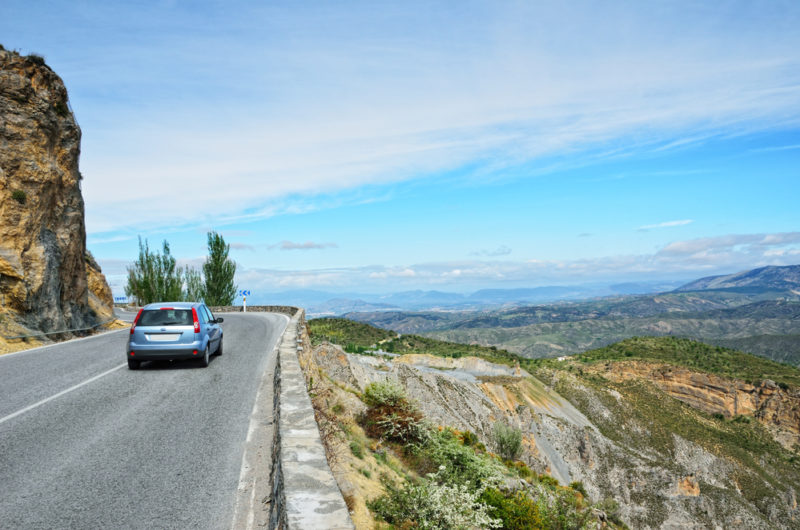Driving in Spain is an exciting and enjoyable experience, but also has challenges. From navigating roundabouts to understanding different regulations, mastering all the nuances can overwhelm even experienced drivers. But with the right preparation, driving in Spain can be an adventure.
This article gives tips and advice for driving in Spain, from understanding laws to designing routes showcasing beautiful places. We also look at what to know about road etiquette and how to stay safe on the road. So whether you’re planning a road trip or just need to be better prepared for your next rental car, this article can help you conquer the roads of Spain.
About Driving in Spain
Basic Rules and Regulations to Drive in Spain
- Drive on the right: In Spain, drive on the right-hand side of the road. The driver’s seat is on the left side of the vehicle.
- Overtaking: When overtaking another vehicle, pass safely on the left side and return to your lane. Overtaking is prohibited near intersections, pedestrian crossings, or solid white lines.
- Roundabouts: Roundabouts are common in Spain. Give way to oncoming traffic already on the roundabout and signal your intention when entering or exiting the roundabout.
- Priority: Yield the right of way to vehicles approaching from the right unless otherwise indicated by signs or road markings. Be cautious at intersections and respect the priority of vehicles and pedestrians when applicable.
- Documentation: Always carry your valid driver’s license, vehicle registration documents, and insurance details. For rental cars, keep the agreement and any necessary documents rental companies provide.
- In an emergency, dial 112 for local emergency services
- Traffic lights are the standard red, yellow and green system
- Spanish license plates have white backgrounds with black characters. The characters are in standard font and size, although slight variations can occur.
Driving Licence and International Driving Permit
To drive in Spain, you must be 18 years of age and have a valid driving licence issued in your home country and an International Driving Permit (IDP). Always carry your valid driver’s license, passport, vehicle registration documents, and insurance.
An International Driver’s Permit (IDP), also called an International Driver’s License, is an official document to drive a private motor vehicle in a foreign country that recognizes the permit. The international permit translates your foreign driving license into multiple languages, making it easier for authorities in other countries to understand your driving credentials.
Speed Limits and Speeding Fines
The general speed limits to drive in Spain are 120 km/h (75 mph) on dual carriageways, 100 km/h (62 mph) on non-urban roads, and 50 km/h (31 mph) in urban areas and 20 in residential areas. These are the standard limits for EU countries. Still, the national speed limit varies depending on weather conditions, specific road sections, or temporary signs indicating different limits.
In addition to speed limits, drive in Spain at appropriate speeds for road conditions, ensuring your safety and the safety of others. Speeding fines start at 100 euros but can go as high as 500 euros. Spain also uses speed camera detectors. You may get on the spot fine or be redirected to the nearest police station.
Seat Belt Rules and Regulations
To drive in Spain, the strict seat belt regulations ensure the safety of all passengers. The driver, rear seat and front seat passengers must always wear belts while the vehicle is in motion, and the driver is legally responsible. Children under 12 and shorter than 135 cm (4.4 ft) must use an approved restraint system while travelling. The specific European Union child restraint system required depends on the child’s age, height, and weight:
- Up to 9 kg (20 lbs): Rear-facing infant carrier or rear-facing child seat.
- 9-18 kg (20-40 lbs): Forward-facing child seat.
- Over 18 kg (40 lbs): Booster seat or booster cushion.
Parking regulations in Spain
Parking regulations in Spain vary. Many urban areas have designated blue zones (zonas azules) where parking is regulated. These zones typically have time limits, and you must display a parking disc (disco horario) indicating your arrival time. The maximum parking duration is usually a few hours.
In some areas, purchase tickets from nearby parking meters (parquímetro) or parking ticket machines (expendedor) and display them on your dashboard. Parking in areas marked with yellow lines (zonas amarillas) is usually prohibited or restricted. These built-up places are often reserved for specific uses, like loading and unloading or emergency vehicles.
Some residential areas may have parking spaces reserved for local residents. These spaces are typically built-up areas with signage indicating resident-only parking (aparcamiento para residentes). Unauthorized parking in these areas may result in fines or towing. If your car is towed, contact local authorities or parking management to provide proof of ownership and pay fines or fees.
Mobile Phones and Alcohol
It is illegal to use handheld mobile phones while driving. Hands-free devices are permitted, but avoiding distractions while driving is best. The legal blood alcohol concentration limit in Spain is 0.5 grams per litre. However, it is advisable to avoid drinking and driving altogether.
Using Toll Roads in Spain
Toll roads, called “autopistas de peaje” or “autopistas de pago,” are an integral part of Spain’s road network. Toll roads are generally well-maintained, providing efficient and faster travel options than non-toll routes. Pay toll payments using cash, credit or debit card/debit cards, or electronic toll collection systems (like VIA-T or Toll Boxes). Electronic toll collection systems allow for automatic payment without stopping at toll booths. They typically require an onboard device or transponder from the toll road operator.
What must I carry in my car when driving in Spain?
When driving in Spain, carry certain items in your car to comply with local regulations. Here are the essential items.
- Valid Driving Licence, insurance and Car Registration Documents: Carry your valid driving licence. This applies to both Spanish residents and visitors. Also carry the ownership or rental documents. Carry insurance coverage that is valid in Spain.
- International Driving Permit (IDP): While an International Driving Permit (IDP) is not a legal requirement for some foreign drivers in Spain, it is recommended to have one.
- Warning Triangles: Carry two warning triangles. In case of breakdowns or accidents, place the reflective warning triangle on the road 50 meters behind your vehicle to alert other drivers.
- Reflective Vest: In case of breakdowns or accidents, each passenger should wear a reflective vest to improve visibility and safety when exiting the vehicle.
- Spare Tyre and Tools: Ensure your vehicle has a spare wheel in good condition and the necessary tools to change it, like a jack and wrench.
- Headlamp Beam Deflectors: If your vehicle has asymmetrical headlights, take headlamp beam deflectors (or adhesive stickers) to adjust the beam pattern for driving on the right-hand side of the road.
Is Driving in Spain Safe?
Driving in Spain is safe, but as with driving in any country, be aware of specific challenges. Rural roads in Spain are often narrower and winding, requiring extra caution. Practice defensive driving techniques and watch the other drivers on the road. Some drivers in Spain may display aggressive or impatient behaviour but stay calm and focused.
Adhere to speed limits of the Spanish law. Ensure all occupants of the vehicle wear seat belts. Lastly, avoid distractions while driving, like mobile phones or activities directing your focus away from the road. Using a handheld mobile phone while driving is illegal unless you have a hands-free system.
Low Emission Stickers and Zones
In Spain, low-emission cars are becoming increasingly popular as Spanish authorities focus on reducing pollution and promoting sustainable transportation. Several cities in Spain, including Barcelona and Madrid, have established Low Emission Zones (LEZs) or Environmental Zones where certain vehicles with high emissions are restricted or subject to additional fees. These zones aim to improve air quality by promoting low-emission vehicles.
Like many other central European countries, Spain has adopted vehicle emissions standards. The European Union’s emission standards apply in Spain. These standards set limits for various pollutants emitted by cars, including carbon dioxide (CO2), nitrogen oxides (NOx), and particulate matter (PM). Spain uses an ECO label system to categorize vehicles based on environmental impact.
Cars that meet specific emission and efficiency criteria receive the ECO label, which provides benefits like LEZs, reduced parking fees, and exemptions from certain driving restrictions. Spain also offers tax incentives and reductions for low-emission vehicles. These incentives include lower vehicle registration tax (Impuesto de Matriculación), reduced road tax (Impuesto de Circulación), and lower toll fees.
Because of this, electric vehicles are gaining popularity in Spain. The government has introduced various incentives to promote the adoption of EVs, including financial incentives, tax benefits, and subsidies. Additionally, charging infrastructure is expanding nationwide, making owning and driving electric vehicles more convenient.
Plug-in hybrid vehicles, which combine an internal combustion engine with an electric motor and battery, are also considered low-emission vehicles. They offer the flexibility of using electric power and traditional combustion engines, making them popular for drivers who want the benefits of electric driving combined with more extended-range capabilities.
Charging Electric Cars in Spain
Charging electric cars in Spain is becoming more accessible as the country continues to expand its charging infrastructure. There are various types of charging stations, including slow chargers (AC), fast chargers (AC and DC), and ultra-fast chargers (DC).
Spain’s most common charging connector types are the Type 2 (Mennekes) connector for AC charging and the Combined Charging System (CCS) for DC fast charging. However, other connector types, like the CHAdeMO connector for DC charging, are found at some charging stations.
Several charging network operators operate in Spain, providing access to their charging infrastructure through membership or pay-as-you-go options. Examples include Iberdrola, Endesa, Repsol, and Electromaps. Many networks have their own mobile apps or RFID cards for accessing and paying for charging sessions.
Charging stations in Spain typically accept various payment methods, including credit/debit cards, mobile apps, and RFID cards. Some stations require prior registration or an app to start charging sessions.
If you own an electric car in Spain, you can install charging points at your home for convenient and overnight charging. This requires professional installation, and you may need permission or permits from relevant authorities. Many hotels, shopping centres, and public parking facilities in Spain offer electric vehicle charging facilities for their guests or customers.
Car Rental Hire in Spain
Renting a car in Spain is ideal for travellers who want to explore the country at their own pace. Well-known international rental companies in Spain include Hertz, Avis, Europcar, Budget, and Sixt. Book rental vehicles in advance, especially during peak travel seasons. To rent a car in Spain, you must typically be at least 21 years old, although some rental companies may have minimum age requirements of 25.
Rental cars in Spain usually come with basic insurance coverage, including Collision Damage Waiver (CDW) and Theft Protection. However, there is usually an excess or deductible amount in case of damage or theft. Consider purchasing additional insurance coverage to reduce or eliminate the extra amount.
Rental cars in Spain also have fuel policies to return the vehicle with the same amount of fuel it had when you picked it up. Check for additional fees or charges like airport surcharges, one-way rental fees, driver fees, or extras like GPS navigation systems or child seats. Carefully review rental agreements and potential extra costs.
Before accepting rental cars, inspect them thoroughly for existing damage. Remember to have your rental car documents, including the contract, insurance papers, licensed vehicle inspection, and contact details of the rental company, readily available during your rental period.
Blue Badge for Disabled Driving in Spain
Blue Badge (Tarjeta de Estacionamiento para Personas con Movilidad Reducida): Disabled individuals can apply for a Blue Badge, which allows them to park in designated disabled spaces. The Blue Badge is issued to the primary driver’s license by local municipal authorities upon meeting specific criteria, like mobility impairments that significantly limit their walking ability.
Disabled drivers with a badge may be eligible for parking fee exemptions or reductions, exemption from time restrictions in limited parking zones, and access to restricted areas or pedestrian zones. The Blue Badge disabled parking permit should be displayed visibly on the dashboard or windshield.
How do Gas Stations in Spain Work?
Gas stations, called “gasolineras” or “estaciones de servicio” in Spanish, are readily available throughout Spain. They offer unleaded gasoline (gasolina sin plomo), diesel (gasóleo or gasóleo A), and sometimes premium gasoline (gasolina 98 or gasolina super). Most are also gas self-service, where you fuel up your vehicle yourself, and are open 24 hours, especially those located along major highways.
They accept various payment methods, including cash, credit/debit cards (Visa, Mastercard, etc.), and contactless payments. Many gas stations in Spain offer additional services and facilities, like convenience stores (tiendas), restrooms (aseos), car washes (lavado de coches), and basic food and beverage options.
Guardia Civil
The Guardia Civil (civil guard) is a law enforcement agency in Spain responsible for various police officer duties, including traffic enforcement and road safety on Spanish roads. The Guardia Civil may be present at major road intersections, highways, and checkpoints to manage traffic, especially during busy periods or events.
They may also be deployed for traffic accidents, road closures, or other incidents. They use speed cameras, radar devices, and mobile checkpoints to monitor and enforce speed limits on Spanish roads and conduct random Breathalyzer tests to detect and deter drunk driving.
The Guardia Civil works regular road safety checks to ensure compliance with regulations like seat belt usage, proper child restraint systems, and vehicle equipment requirements. They may also check for valid documentation like driving licences, vehicle registration, and insurance. They issue fines and penalties, of which the cost varies that you may need to pay immediately and, in more severe cases, temporarily suspend driver’s licenses.
Non-compliance with traffic laws results in fines, driver’s license points, or other legal consequences. When interacting with the Guardia Civil, cooperate, remain calm, and follow their instructions. Treat them respectfully and provide necessary documents (driver’s license, vehicle registration, and insurance) when requested.
Driving a foreign car in Spain
You can drive foreign vehicles in Spain for up to six months. The exception is if you are a Spanish resident, in which case, this is reduced to 30 days. If you go over this, your car may be impounded, and you will be asked to pay import tax. The other option is to register a foreign car but be aware this is costly.
Summary and More Reading About Spain
The unique driving culture of Spain, characterized by aggressive drivers, challenging traffic, and unfamiliar signs, can make the experience of driving in Spain intimidating for visitors. By following the tips in this article, though, even the most cautious driver can navigate the Spanish roads with ease and confidence.
Driving in Spain is an experience to be enjoyed, and with the right preparation and attitude, it can be a great way to explore the country. In which case, this article about the best places to visit in Spain will be useful. Think of all the places you can visit.
Why is Spain so Popular? With a tourism industry that welcomes roughly 80 million people, the fame the country earns worldwide is undeniable, and Spain ranked as the second most visited destination before Coronavirus struck. Yet, answering the question is not so simple because many reasons exist for why Spain ranks as a global tourism destination and for foreign homeownership. Let’s look at what sets Spain up as a global hub.












